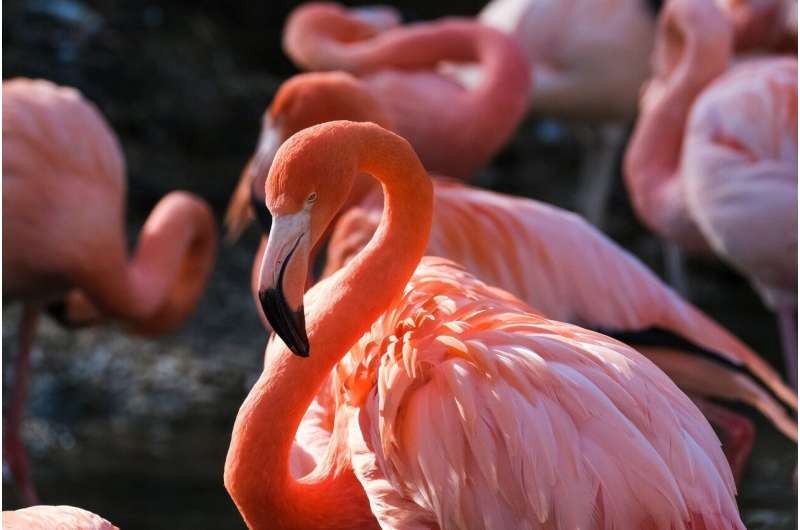This article has been reviewed according to Science X's editorial process and policies. Editors have highlighted the following attributes while ensuring the content's credibility:
fact-checked
peer-reviewed publication
trusted source
proofread
Flamingos don't preen more than other waterbirds, study shows

Despite their famously fancy feathers, flamingos don't spend more time preening than other waterbirds, new research shows. Scientists watched five of the world's six flamingo species to see how they spend their time.
The paper, published in the journal Applied Animal Behavior Science, is titled "What influences feather care and unipedal resting in flamingos? Adding evidence to clarify behavioural anecdotes."
While preening time varied, overall flamingos were roughly average compared to existing studies of other waterbirds.
The researchers also examined time spent standing on one leg—finding that captive flamingos most often do this indoors and in water.
The study was carried out by the University of Exeter and WWT Slimbridge Wetland Center.
"It is widely believed—even among zookeepers—that flamingos spend more time than other birds preening their feathers," said Dr. Paul Rose, from Exeter's Center for Research in Animal Behavior.
"But this hadn't been tested until now—and we were surprised to find they are roughly 'middle of the road' among waterbirds.
"The waterbirds that spend the most time preening are actually Pelecaniformes such as pelicans, gannets and cormorants—which makes sense, as these birds spend the most time in water, and therefore need to maintain feathers for waterproofing.
"Even so, we expected flamingos to be top of the preening charts, as lush pink feathers are so important in their courtship displays."
The study also found that captive waterbirds spend more time preening than wild birds.
Like many birds, flamingos stand on one leg to save energy and to allow half of their brain to sleep. By doing so in water, flamingos reduce heat loss (only one foot loses heat to the water, rather than two).
Rachael Kinnaird, who worked on the study as part of an MSc in Animal Behavior at Exeter, said, "Our study shows the value of observing animals to understand their behavior.
"In this case, a widely held belief about flamingos preening more than other waterbirds didn't hold true."
Commenting on the wider importance of the study, Dr. Rose said, "By understanding why flamingos behave in certain ways, we can predict how climate and habitat change might affect them.
"At present, greater flamingos are seeing their range expand due to climate change. Meanwhile, mountain species such as Chilean and Andean flamingos are really suffering.
"Studying captive flamingos can help us understand what their wild counterparts need.
"We hold so many species in zoos around the world—so the opportunities to study them, to learn how and why they have evolved, are huge."
More information: Paul E. Rose et al, What influences feather care and unipedal resting in flamingos? Adding evidence to clarify behavioural anecdotes, Applied Animal Behaviour Science (2024). DOI: 10.1016/j.applanim.2024.106364
Journal information: Applied Animal Behaviour Science
Provided by University of Exeter





















